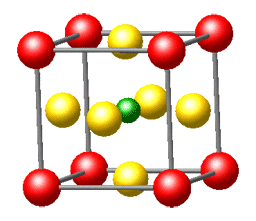
Prof. Dr. Richard Dronskowski
Chair of Solid-state and Quantum Chemistry

 view of our Institute 
|
Chair of Solid-State and Quantum Chemistry
Welcome to the Chair of Solid-State and Quantum Chemistry at RWTH Aachen University, Europe's largest Technical University dating back to the year 1870. The following pages are intended to offer you a short overview of our research and teaching activities in the fields of solid-state and quantum chemistry. If you are interested in these exciting chemical disciplines, you have come to the right place. Stay with us! Don't go away!
HOT: Topological Photoluminescence in a Ternary Tb(III) Cyanamide
Recently, low-dimensional lanthanide-based systems have received particular attention for their interesting magnetic and luminescent properties. We present the synthesis of a stoichiometric Tb(III) cyanamide which crystallizes in an orthorhombic structure where the magnetic Tb3+ ions are arranged in well-separated one-dimensional chains parallel to the c axis. Luminescence studies show phosphor-like behavior with a process of energy migration probed to be one-dimensional due to the large difference in the size of the intra- and interchain transfer probabilities. A long luminescent lifetime of 1.22 ms was observed at 100 K. In contrast, AC magnetic susceptibility studies reveal a slow magnetic relaxation process, with a relaxation time of 4.03 μs, thus establishing a good correlation between the compound’s 1D structure and its luminescent and magnetic properties.
DOI:10.1021/acs.chemmater.4c03264
HOT: Orbital-Based Bonding Analysis in Solids
There is certainly no doubt about the quantum character of the atomistic world, most straightforwardly calculated by using wave mechanics and Schrödinger's fundamental equation. The paramount importance of the wave function remains unchanged, and the wave function is most conveniently approximated by a combination of orbitals, for atoms, molecules, and also solids. And it is precisely this “orbital basis” that serves as a gateway to understanding the very interactions that cause atoms to condense into solids. The analysis of quantum-chemical interactions and the nature of the chemical bonding between atoms in solids by use of orbitals is the topic in this perspective. As electronic structures for periodic solids are most often calculated using plane waves, for simple reasons of translational symmetry and Bloch's fundamental theorem, a unitary transformation to atomic or molecular orbitals is needed for final inspection, technically solved by the LOBSTER quantum-chemistry package. It allows for the calculation of wave function-based atomic charges, various population analyses and periodic bonding indicators, first-principles bond orders, two- and multi-centre bonding analysis, fragment-molecular analysis, and a lot more. All those techniques are illustrated from three solid-state systems deriving from carbonate chemistry.
HOT: Anderson’s negative-U chemistry in amorphous silicon nitride
P. W. Anderson introduced a negative-U (i.e., attractive electron-electron interaction) to describe the scarcity of singly occupied spin states in amorphous materials. To uncover the underlying chemistry behind this phenomenon, we combined structural sampling with quantum-chemical analysis of amorphous silicon nitride (a-SiNx) based on DFT. Our analysis demonstrates that coordination defects act as charge traps, with a density on the order of 1021 per cubic centimeter. These defects render singly occupied electronic states energetically less favorable than paired or fully emptied states, primarily due to electron donor-acceptor interactions. Furthermore, excess charge trapping occurs through chemical bond reorganization, which disrupts the balance of existing electron and hole traps. In addition, we found that in Si-rich a-SiNx, various Si-Si bonding networks exhibit power-law–like size distribution, where larger networks are associated with deeper trap levels. These findings explain why a-SiNx has been used as a charge storage layer in the charge trap flash memory.
Solid-State Chemistry
Teaching
|
Computational Chemistry
Location
|

